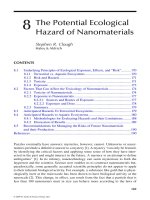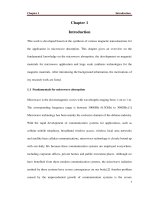Synthesis of various magnetic nanostructures and the microwave characterizations 8
Bạn đang xem bản rút gọn của tài liệu. Xem và tải ngay bản đầy đủ của tài liệu tại đây (272.34 KB, 6 trang )
Chapter 8 Conclusions and future works
139
Chapter 8
Conclusions and future works
8.1 Conclusions
Various magnetic structures, including Fe/SiO
2
core/shell, micron- and submicron-
Fe/Al flakes, Fe
3
O
4
rings, Fe
3
O
4
tubes, Fe
3
O
4
rods, Fe
3
O
4
and Zn-ferrite nanocrystals,
were successfully prepared for microwave applications in this work. Large scale
synthesis methods were developed for the microwave measurements. The
achievement on the synthesis and the findings in the microwave absorption
performance of as-synthesized magnetic nanostructures are concluded below:
Fe
90
Al
10
flakes with micron- and submicron-sizes were fabricated via different
milling routes. Traditional wet ball-milling process with pure ethanol as additive
was performed to prepare micro-sized Fe/Al flakes. With increasing wet-milling
time, the flake size increases. For Fe/Al submicron-flakes, Micron-Master Jet
Pulverizer (so called jet mill) was employed. The results reveal that Fe
90
Al
10
submicron-flakes with an average lateral size of 500 nm could be obtained
through the combination of ball milling and jet milling. Microwave performance
of the obtained Fe
90
Al
10
flakes with different sizes was further studied.
Monosized octahedron-shaped magnetite (Fe
3
O
4
) nanoparticles with average
sizes ranging from 6 nm to ∼ 430 nm were synthesized via a thermal
decomposition route. The novelty of the method is that only one kind of
surfactant (oleic acid) is used in the synthesis process. Therefore, the size of
Chapter 8 Conclusions and future works
140
Fe
3
O
4
nanoparticles is easily tuned by adjusting the molar ratio of surfactant to Fe
precursor. In other words, we are able to adjust the magnetic properties of the
as-synthesized nanoparticles from superparamagnetic to single-domain to
multidomain regimes.
Nonstoichiometric zinc ferrite (Zn
d
Fe
3-d
O
4
) nanoparticles with d ranging from 0
to 0.5 were synthesized via thermal decomposition route employing oleic acid as
surfactant. The zinc dopant concentration was controlled by the ratio of Zn/Fe
precursors. High room temperature saturation magnetization of 110 emu/g was
obtained for large Zn-ferrite particles (more than 100 nm) with nominal
composition of Zn
0.468
Fe
2.532
O
4
. The origin of the extraordinary magnetic
property was revealed as the Zn substitution of Fe atoms at the tetrahedral site (A
site) in the spinel magnetite phase. It has been found, that the precursor/surfactant
ratio was an important parameter for the control over the shape and size of
as-synthesized Zn ferrite particles. Hence the developed thermal decomposition
method is not only suitable for the synthesis of high quality Fe
3
O
4
nanoparticles,
also suitable for the synthesis of Zn-ferrite nanoparticles with novel properties.
Fe
3
O
4
particles with some novel structures (rings, tubes and rods) were
synthesized via chemical reduction route by employing -Fe
2
O
3
particles as
templates. In the reduction process, both of surfactant (oleic acid) and protective
gas (5%H
2
/95%Ar gas mixture) were employed to complete the phase
Chapter 8 Conclusions and future works
141
transformation. The effect of oleic acid and H
2
gas on the reduction process of
-Fe
2
O
3
particles was studied through a series of experiments. The results
indicated that the chemical reduction method was convenient and feasible to
reduce various hematite particles to pure magnetite phase.
The insulating SiO
2
shell layer is effectively to suppress the skin effect of Fe
particles, which makes the microwave permeate into the microwave absorber
more easily. As a result, the resonance peak corresponding to the lowest reflection
loss shifts to higher frequency band. Compared to the spherical Fe/Al alloys, the
Fe/Al flakes show two advantages on the microwave absorption. The one is that
the thickness of the flakes is rather smaller than the skin depth, thus the incident
microwave can permeate into the particles. The other one is that the introduction
of shape anisotropy could enhance the Snoek’s law limitation, resulting in a
higher resonance frequency. Therefore a great improvement has been made on the
microwave absorption by shaping the metallic alloy into flakes. The frequency
peak shifts to higher band with decreasing the lateral size of flakes. By studying
the microwave absorption performance of various Fe
3
O
4
nanostructures, we also
found that the shaped structures (ring, tube and rod) could greatly enhance the
resonance frequency to higher band. Especially for the Fe
3
O
4
nanorods, the
resonance peak shifts to 4.82 GHz. As for effective microwave absorption, a
balance between the high resonance peak and the high permeability should be
Chapter 8 Conclusions and future works
142
found. Fe
3
O
4
rings with an outer diameter of 154 nm show a moderate resonance
frequency (4.01 GHz) but a relative low reflection loss (-28 dB) compared to
Fe
3
O
4
particles with other structures. As investigated, Zn-ferrite particles with
very high saturation magnetization (104 emu/g) show a very high permeability
value of 1.4 at the resonance frequency 3.45 GHz, resulting in the lowest
reflection loss of -38 GHz in this work. As predicted by the Snoek’s law, the high
saturation magnetization is very necessary for effective microwave application.
8.2 Future works
(1) This study introduces the effect of jet milling process on the large alloys particles.
The use of jet mill may allow us to reduce the particles size to less than 5 μm.
Although the reported ball milled particles are of nanocrystalline structure, the
irregular shape and broad size distribution of ball milled products are still
problems in practical applications. For example, the application as microwave
absorber requires the magnetic particles dispersing in the medium. The
non-homogenous dispersion of magnetic particles in medium may come from the
broad size distribution, which is bad for the microwave absorbing performance.
Thus the jet milling machine is useful to overcome this problem. In future, the use
of jet milling for the synthesis of submicron Fe/Al flakes may be tried on other
materials.
(2) The thermal decomposition method is adopted to synthesize monosized Fe
3
O
4
and
Chapter 8 Conclusions and future works
143
Zn-ferrite particles. The particles size could be tuned from hundreds of
micrometers to several nanometers. Fe
3
O
4
and Zn-ferrite particles with large size
(above 100nm) have been applied as microwave absorber. The mechanism on the
multi microwave absorption peaks of as-synthesized Zn-ferrite particles is still
unclear. In future, some simulation work could be performed to make it clear.
Besides, we have also presented some small Fe
3
O
4
and Zn-ferrite particles, which
are superparmagnetic. It is expecting to apply these small nanoparticles into
biomedical applications, such as hyperthermia for cancer therapy. Besides
Zn-ferrite, the other members in spinel family, such as Mn-, Ni-ferrite as well as
Mn/Zn-,Ni/Zn-ferrite can also be synthesized by using the developed thermal
decomposition method. They are highly demanded as soft magnetic materials. It
would also be very interesting to study the properties of other kinds of spinel
ferrites synthesized by the developed thermal decomposition method.
(3) The novelty of as-developed chemical reduction method lies in its simplicity as
well as its capabilities on reducing various α-Fe
2
O
3
particles. It can be used to
produce Fe
3
O
4
particles with more novel structures in future. The applications of
as-reduced Fe
3
O
4
particles are very promising. According to the simulation work
based on Landau-Lifshits-Gilbert (LLG) equation done by our group member, the
anisotropic Fe
3
O
4
particles such as tubes and rods could exhibit very high
permeability values when they are aligned parallel to the incident microwave.
Chapter 8 Conclusions and future works
144
Hence the technique on the sample preparation for microwave measurement could
be improved to build aligned structure. One of most interesting nanostructures is
the Fe
3
O
4
discs, which has been produced via the developed chemical reduction.
The aligned structure of Fe
3
O
4
disks and its microwave absorption performance is
under studied currently. Future works are expected to be related with the magnetic
and electrical properties of as-obtained Fe
3
O
4
particles with various structures as
well as their applications, such as battery, biomedical and magnetic applications.









